If you're like me, you want to make your home a playground for your cat. It can be tough figuring out how to do that. I know the feeling of searching everywhere for ideas that are both safe and stylish.
That's when I dove deep into looking at all sorts of cool designs, like catastrophic creations made just for cats.
I'm excited to share with you some simple ways to turn your place into a cat paradise. We'll talk about using cat walls, shelves, and bridges — all made with materials that won't harm your furry friend.
Get ready to watch your cat explore their new fun space!
Travel with Your Furry Friend – Find Pet-Friendly Deals on Aviasales 🐾🌍
Key Takeaways
- Start your cat wall about 14 inches off the ground. Use wall studs to make it strong. Make sure cats have a safe spot to land.
- Plan around how cats and people move in your house. Use shelves and hammocks in corners, over doors, and near windows to create fun spots for cats.
- Choose safe materials for your cat's wall. Check that the shelves can hold a cat's weight. Use non-toxic paints and fabrics.
- Install hammocks over doorways for extra cozy spots. Measure carefully and use grommets for secure hanging.
- Add different levels and angles to keep your cat active. Block paths you don't want them on with furniture or baby gates
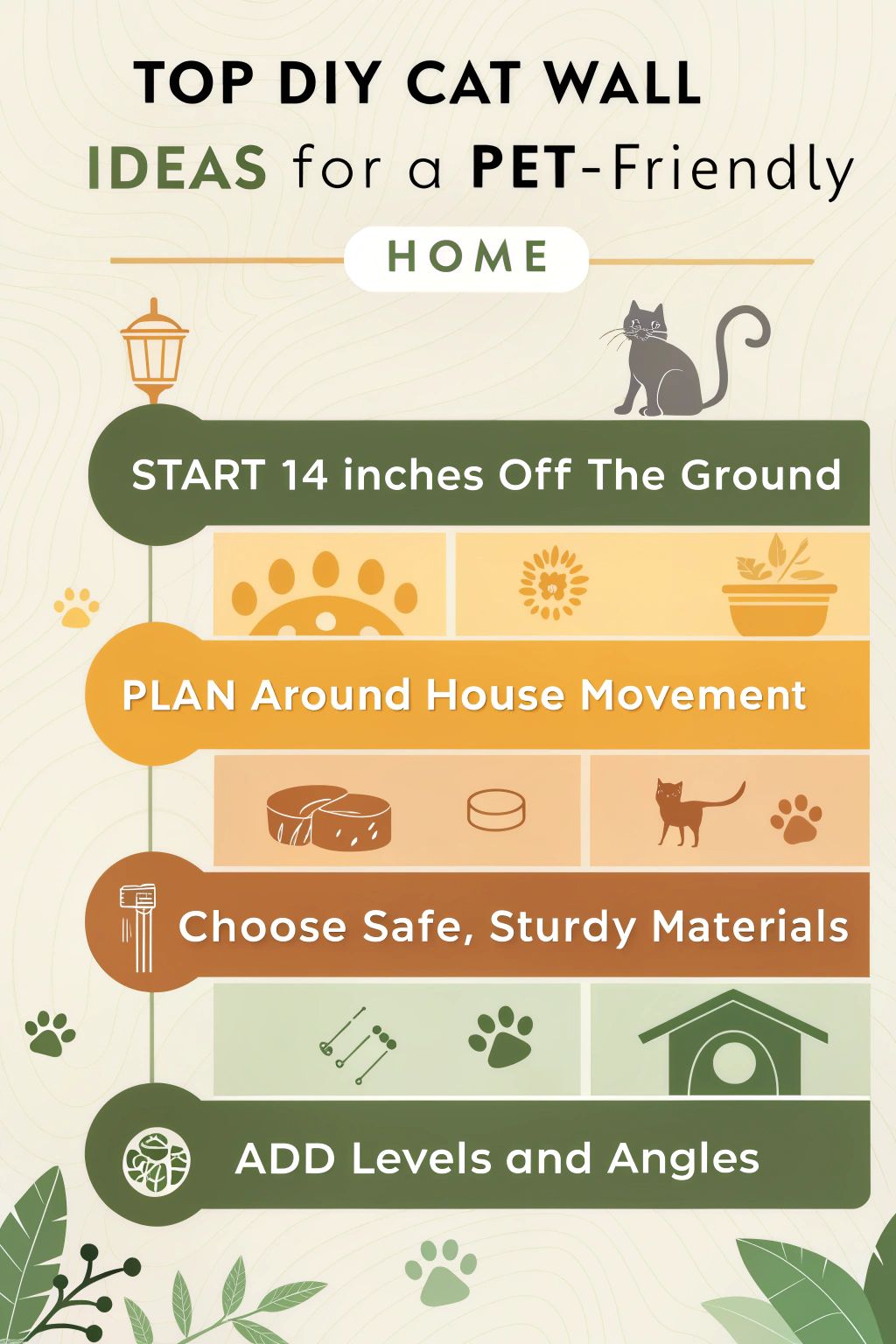
Planning Your Cat Wall
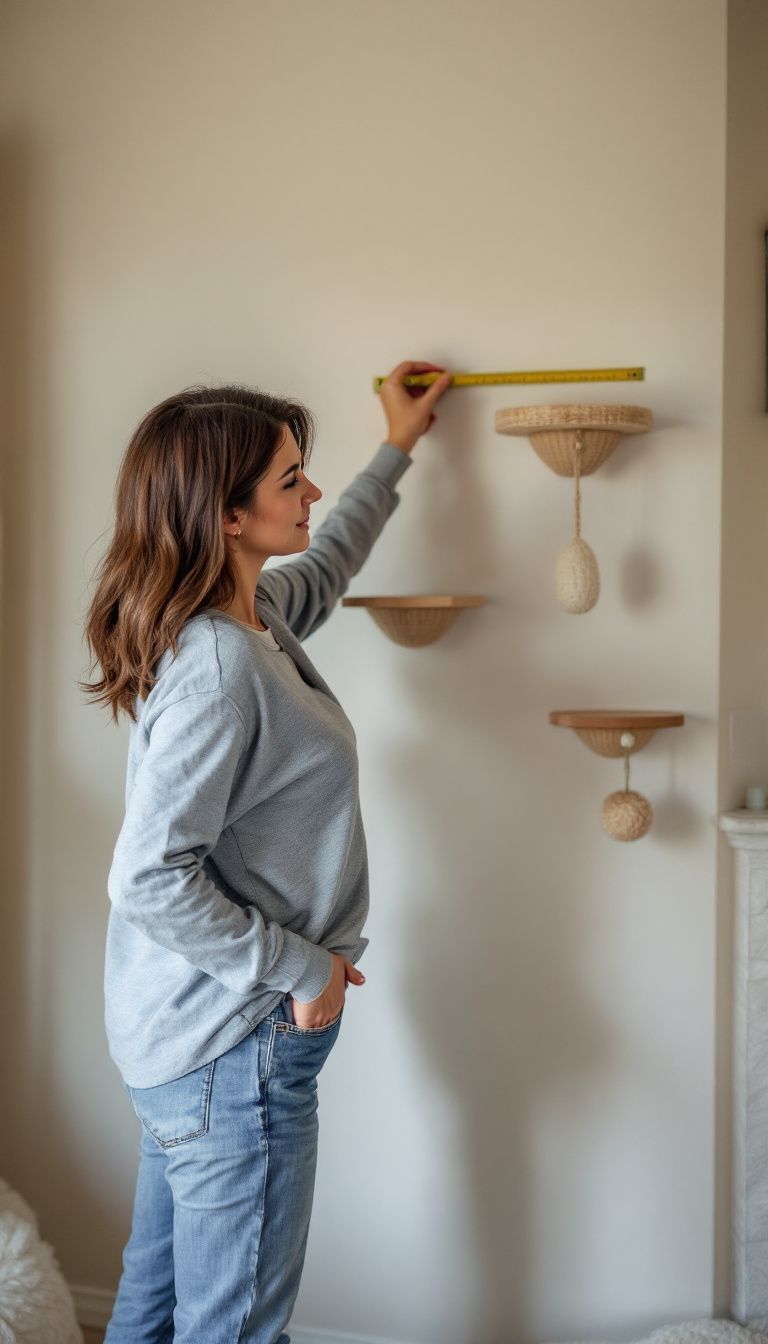
Getting ready to make your cat wall starts with two things: where it begins and where it ends. Think about how your cat moves and the busiest spots in your house.
Starting and Ending Points
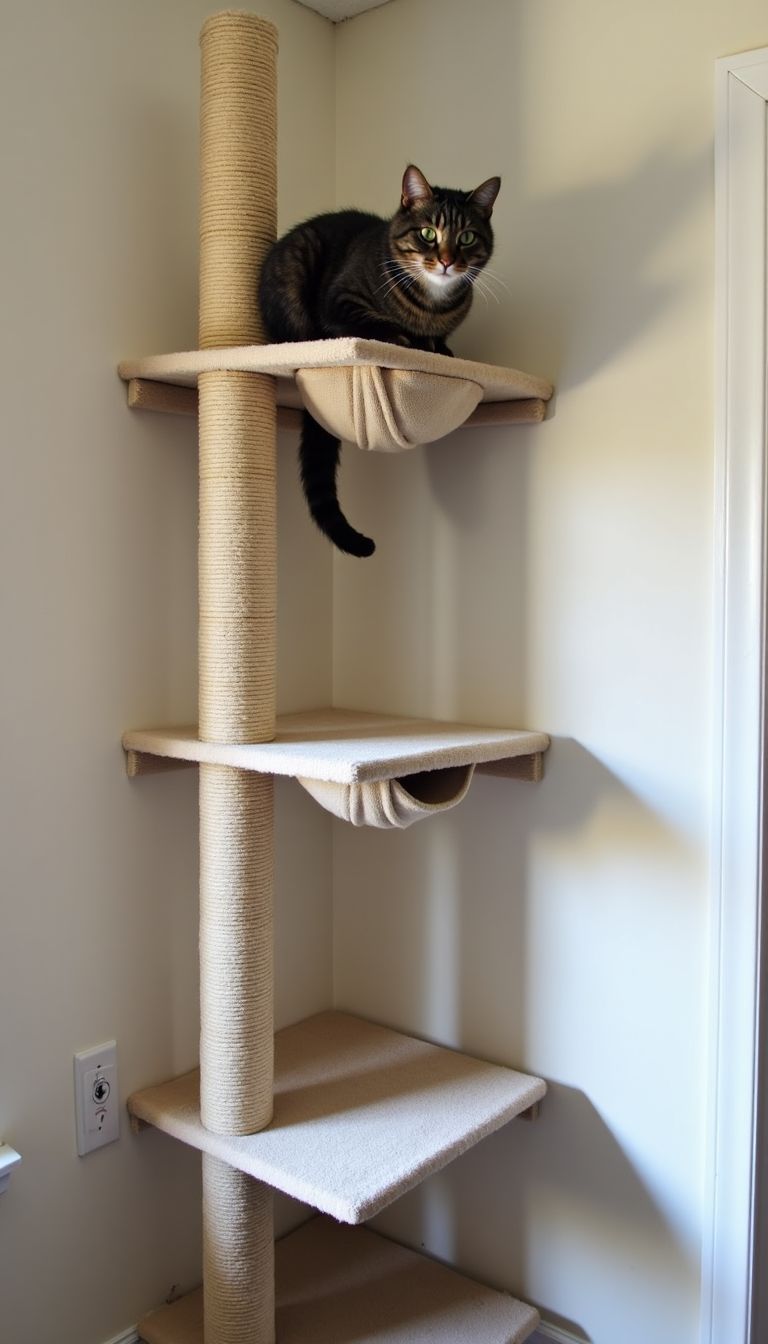
I start my cat wall at about 14 inches off the ground. This makes it easy for my cats to jump on. I always make sure to find wall studs near corners and doorways. This helps keep everything stable.
I learned that ending points are just as important as where you start. It's best if there is a clear spot for your cat to jump down safely. I use shelves or hammocks here, too, so they can land softly.
A good plan today is better than a perfect plan tomorrow.
Using this advice, I take time planning each step of my cat wall. From starting low to creating safe landing spots, every choice keeps my pet in mind. Plus, checking for wall studs ensures a sturdy setup from beginning to end.
Considering Traffic Flow and Cat Behavior
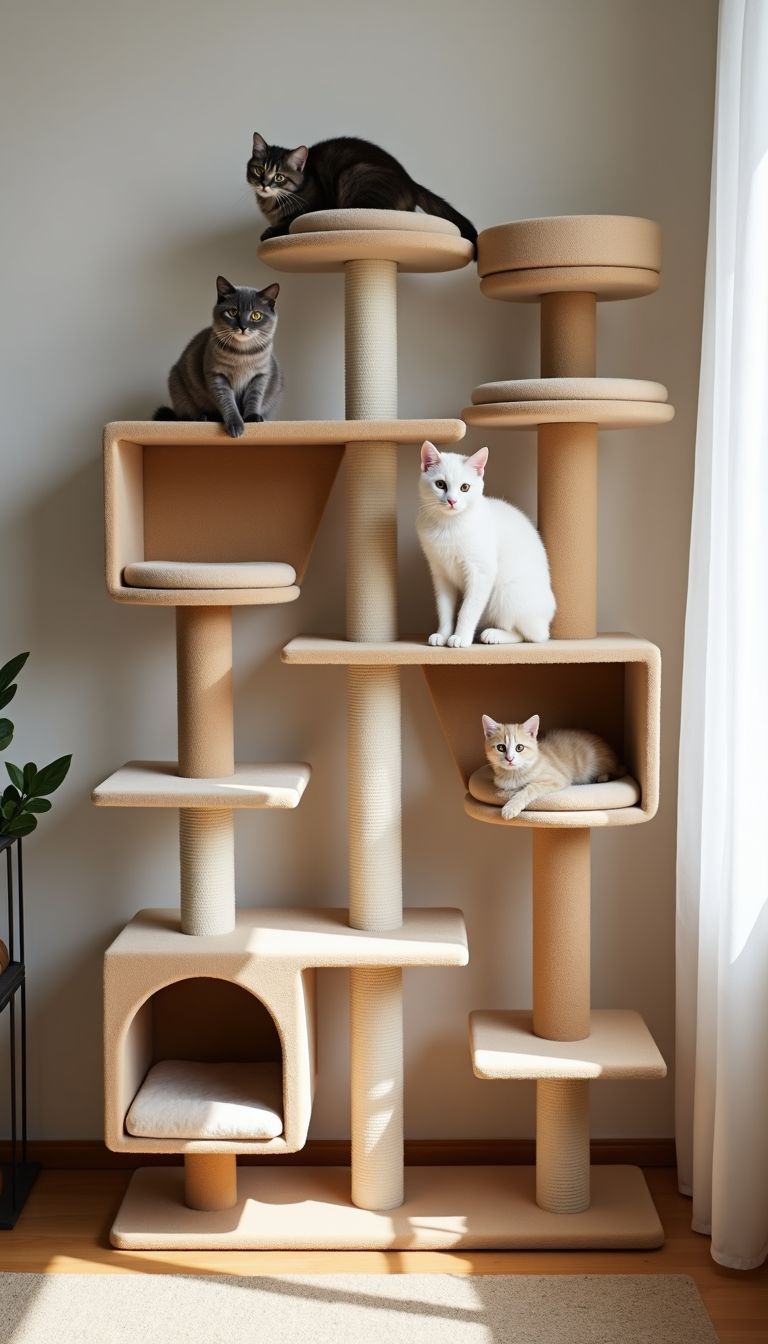
I focus on traffic flow and cat behavior when planning my cat wall. Cat paths should be easy for them to use. I keep the distance between steps of shelves about 12-18 inches apart.
This helps cats jump comfortably.
Some cats are shy or active. Kittens love climbing and scratching poles. They enjoy sprinting along the wall, too! Older cats need safe routes without sudden jumps. I make sure there are cozy spots for them to relax.
It’s important to think about how people move through the space, too. If doors swing open, they shouldn't hit a shelf or step. Balancing human movement with cat needs keeps everyone happy in my pet-friendly home design.
Utilizing Home Spaces

Cats love high places. You can use corners, doors, and windows for their climbing fun. Install hammocks above doors for cozy spots. Cats will enjoy watching the world from up there…
and it saves space too!
Corners, Doors, and Windows
Corners, doors, and windows provide great spots for cat walls. I can use these spaces to make my home more fun for my cat.
- Corners are perfect for cat perches or beds. They give my cat a high place to watch the room.
- Slotted cat shelves fit well in corners. I can adjust them for different heights, creating fun ways for my cat to walk.
- Doors can turn into vertical spaces. I might add shelves or steps that lead up and over the doorframe.
- Windows are another smart choice. Installing shelves near windows lets my cat enjoy the outside view while lounging.
- Hammocks can be hung above doorways. This gives a cozy spot where my cat can relax while still being part of the action.
- Cat trees near windows add height and excitement, too. They create a fun space where my pet can play and nap safely.
Using these areas makes it easy to have a happy, cat-friendly home design!
Wall Mounted Cat Furniture 18 Piece Set
Installing Hammocks Over Doorways
Mounting hammocks over doorways is fun and creative. I love how it gives my cats a cozy spot to lounge. Here are the steps I follow:
- Measure Widths: First, measure the width of your doorway. This helps me know how long my hammock needs to be.
- Check Grommet Spacing: I chose a hammock with strong grommets for hanging. Their spacing helps keep the fabric tight and secure.
- Locate Wall Studs: Finding wall studs is key! I locate the nearest stud at the edge of the doorway for secure mounting of the first plank.
- Install First Plank: Using screws, I mount the first plank to this stud. It needs to be straight for safety.
- Position Second Plank: The second plank goes on next… but 0.75 inches lower than the first one—this ensures proper hammock positioning.
- Tighten Fabric: Before letting my cats use it, I pull the fabric tightly for stability. This makes sure they are safe while jumping in and out.
- Test Stability: Lastly, I recheck everything before allowing my felines to try it out.
Creating these spaces not only entertains them but makes our home feel more customized, too!
Design Elements and Materials
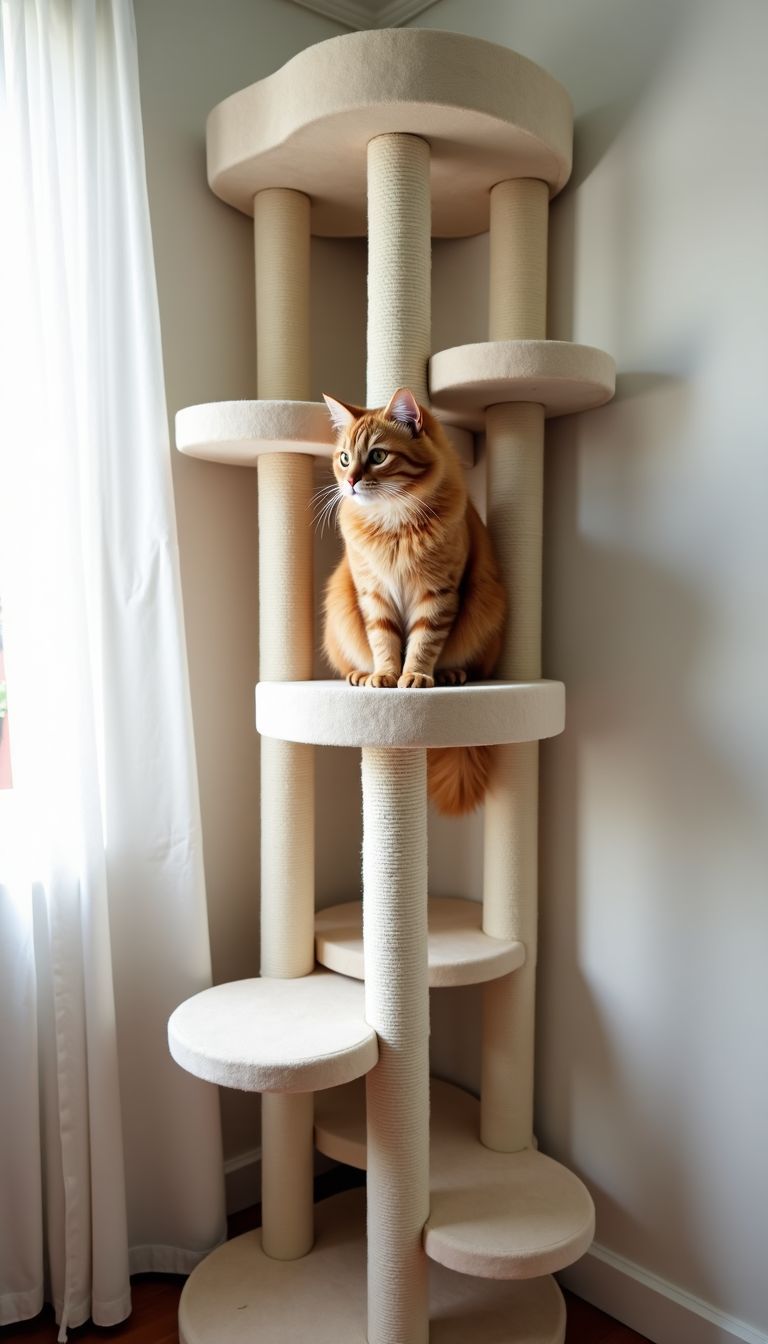
Choosing the right shelves and steps matters. You want to create a fun space for your cat, while also keeping it safe. Soft fabric on walls can add style too. It makes the area cozy for your furry friend…
and looks good in your home!
Choosing Cat Shelves and Steps
I enjoy finding the best shelves and steps for cats. It helps create a fun space for them. Here’s what I consider:
- Materials: I use wooden boards that are at least 1/2 inch thick. This gives strong support for my cats.
- Dimensions: The shelves should be 12 inches deep and 18 inches wide. These sizes help keep the shelves stable.
- Spacing: I place Catastrophic Creations shelves either 16″ or 24″ apart on the wall. This spacing is ideal for balance and safety.
- Support Brackets: It's smart to put support brackets every 16 inches. This way, the shelves won't sag or break easily.
- Steps Variety: Adding different types of steps can make climbing fun. I mix in ramps, ledges, and platforms to keep my cat engaged.
- Design Options: I love using fabric walls for style, too! They add a cozy look while being safe for cats to climb on.
- Color Choices: Picking colors that match my home makes it feel more personal… Cats like comfort, so softer shades work well too.
- Weight Limit: Each shelf must hold enough weight for my cats to jump safely without worry.
Using these tips helps create a cat-friendly home that looks great!
Christmas Solid Wood Cat Wall Shelves
Using Fabric Walls for Aesthetic Appeal
Choosing the right cat shelves and steps is fun. I can make my home cozy for my cats. Fabric walls add beauty and style to any room. They come in many colors and patterns, helping match other parts of the house.
Textured wall panels are great too. They offer space for scratching while protecting your walls. Using materials like sisal, cork, or carpet tiles makes it easy to create a designated scratching area that looks good! With durable paints and scratch-resistant wallpapers, I can keep things neat while making my home inviting for my cats…
What a win-win!
Safety and Durability

Your cat's safety comes first. Use wall studs to make sure your shelves and steps don’t fall. Choose materials that cats can safely chew on or scratch. A strong design will last longer and keep your furry friend safe….
Ensuring Stability with Wall Studs
Cats need safe spaces to play and explore. Proper installation of cat shelves is key for their safety.
- Shelves must be secured to wall studs. Drywall alone cannot hold the weight of your cat and the shelf.
- Locate the wall studs before building your cat wall. The distance between studs can change from one house to another.
- Use a stud finder for accuracy. This tool helps find the right place to install shelves securely.
- Cat shelves should be attached to solid materials like concrete or brick, too. These surfaces provide extra stability for active cats.
- If installing high up, ensure everything is sturdy. Cats might jump around, so stability is crucial for their safety.
- Check all screws and brackets regularly. They can wear down over time, which could lead to accidents.
- Consider using L-brackets for extra support on shelves. They add strength and peace of mind while your cat plays.
- Make sure materials are safe for cats too. Avoid anything that could harm them during their adventures.
This preparation leads directly into measuring and finding wall studs—an important step in the process…
Metal Cat Wall Shelves and Perches
Materials Safe for Cats
Cat furniture must be safe for our furry friends. I choose materials that are non-toxic. This keeps my cats healthy and happy. Wood is great, as long as it’s strong enough to handle climbing and scratching.
I also love using fabric walls. They can look nice and feel soft for the cats. Just make sure any material used is durable, too. Safety comes first… Our pets deserve a cozy space without worries about harmful substances!
Installation Tips

Measuring your walls is key. Find the studs for strong support… Use a tape measure to mark spots before you start. This helps ensure everything fits just right. A simple tape trick can help with placement, too.
Simply place it where you want the shelf to be and adjust as needed.
Measuring and Finding Wall Studs
I start my cat wall project by finding the right height for my cat shelves. I use a laser measurement tool to mark this on the wall. This step is key because it helps determine where everything will go.
Next, I look for the studs in the wall. Studs are strong parts of the frame that hold weight. I use a stud finder for this task. The Catastrophic Creations shelves fit 16″ or 24″ apart, so knowing where these studs are makes installation easier and safer.
Finding both measurements early keeps my design stable…and my cats safe!
Climbing Shelves with Moon Cats House
The Tape Trick for Perfect Placement
Using painter's tape helps me place cat shelves just right. I outline where I want the shelves to go. This way, I can see how it looks on the wall before drilling any holes. It saves time and keeps my walls safe from unnecessary damage.
I keep in mind that cats need some space to move around. The recommended space is 12-18 inches vertically and 12-16 inches horizontally between each shelf. This ensures my cats can jump and explore without feeling cramped.
Using this trick makes planning easier… I'm able to visualize the layout better, too!
Enhancing Cat Wall Functionality
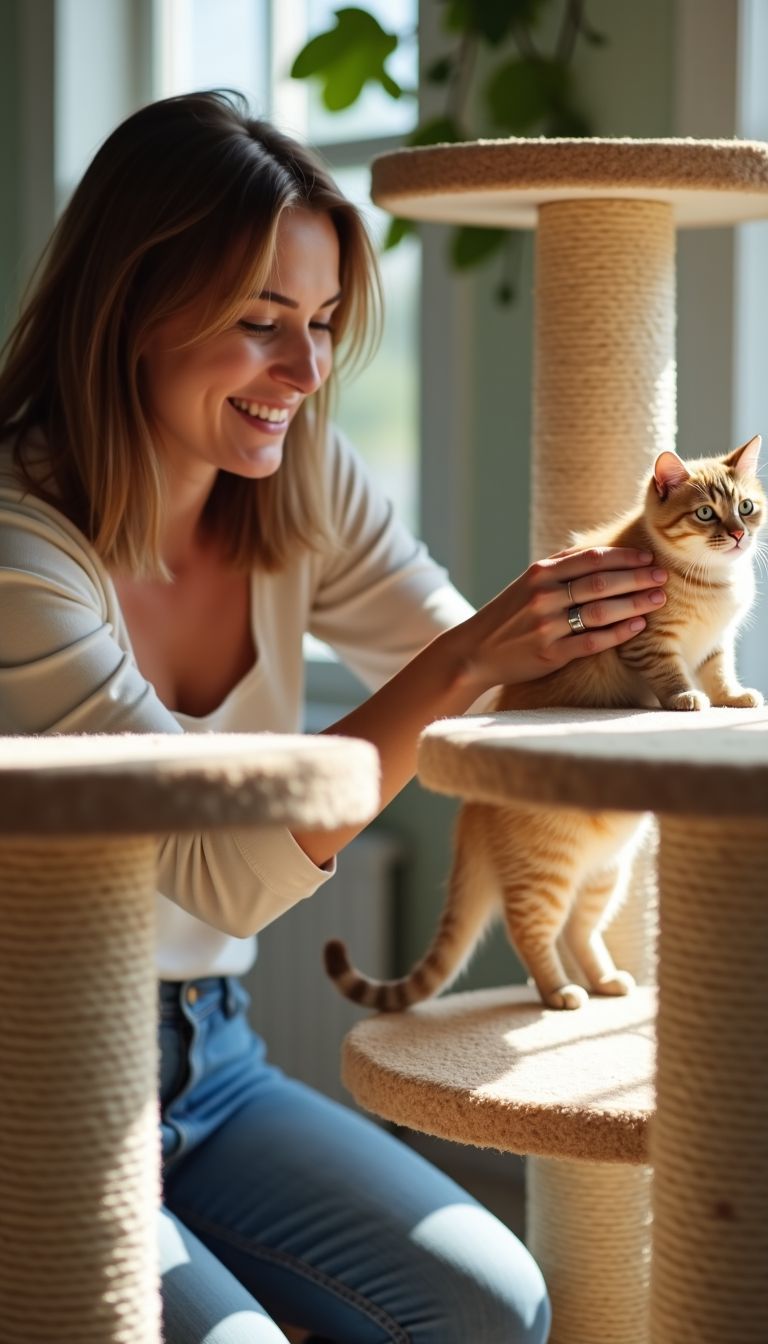
To make your cat wall more fun, add some tricky jumps. Cats love to climb and explore, so create spots that challenge them and keep them active….
Creating Awkward Jumps for Exercise
Creating awkward jumps helps my cat stay fit. It also keeps heavier cats safe from high spots. Here’s how I do it:
- Use Tall Shelves: I place tall shelves at different heights. This creates a challenge for my kitty. She must think before she jumps.
- Add Unusual Angles: I use angled platforms to make her hop differently. These angles give her a workout and prevent boredom.
- Limit Spaces Between Jumps: I keep some gaps small, so she really needs to stretch for the next jump. It helps her build muscles.
- Create A Maze: I design paths that require turning or twisting to navigate them. This keeps her agile and active.
- Mix Up Heights: Some jumps are low while others are high. This variation makes sure she uses all her skills, keeping it fun and safe.
- Incorporate Obstacles: I add items like tiny boxes or soft toys between jumps. They force my cat to find new ways to move around.
- Monitor Her Progress: I watch how easily she manages these challenges. If it seems too easy, I change things up again.
This method works well for lighter cats too, boosting their agility while keeping them entertained… Now, let's discuss managing movement effectively in our cat wall design!

Blocking Routes to Manage Movement
Blocking routes can help control my cat's behavior. This way, I can keep my cat safe and manage their movements better.
- Create Barriers: I place furniture to block paths. This helps my cat stay out of areas they shouldn’t access, like the kitchen or near the dog's food.
- Use Cat Trees: I put tall cat trees in strategic spots. They give my cats places to climb while keeping them away from other rooms.
- Install Shelves: Adding shelves on the walls creates levels for my cats. If I block pathways, they can jump onto shelves instead of wandering around.
- Utilize Doors: I close doors to limit access to specific rooms. It keeps my pets focused on their designated areas and prevents chaos.
- Distraction Zones: Setting up fun toys in certain areas keeps my cats entertained where I want them. This diverts their attention away from blocked paths.
- Elevated Surfaces: Blocking ground paths encourages climbing over furniture or shelves instead, which gives them exercise and satisfies their natural behaviors.
- Adjustable Barriers: Sometimes, I use baby gates as temporary barriers. They are easy to move when needed, allowing me flexibility in managing spaces.
- Monitor Behavior: Observing how my cats react helps me adjust blocks as needed. Their behavior shows me what works best for each of them.
- Safety First: Ensuring that all blocked routes are safe is key for me. I check that no sharp edges or unstable items can harm my pets.
- Enjoying Peace: All this planning makes our home more peaceful and organized for everyone—cats included!
These steps help control movement effectively while keeping things safe for both my cats and the dog… Happy home, happy pets!
Conclusion: Enjoying Your New Cat-Friendly Space
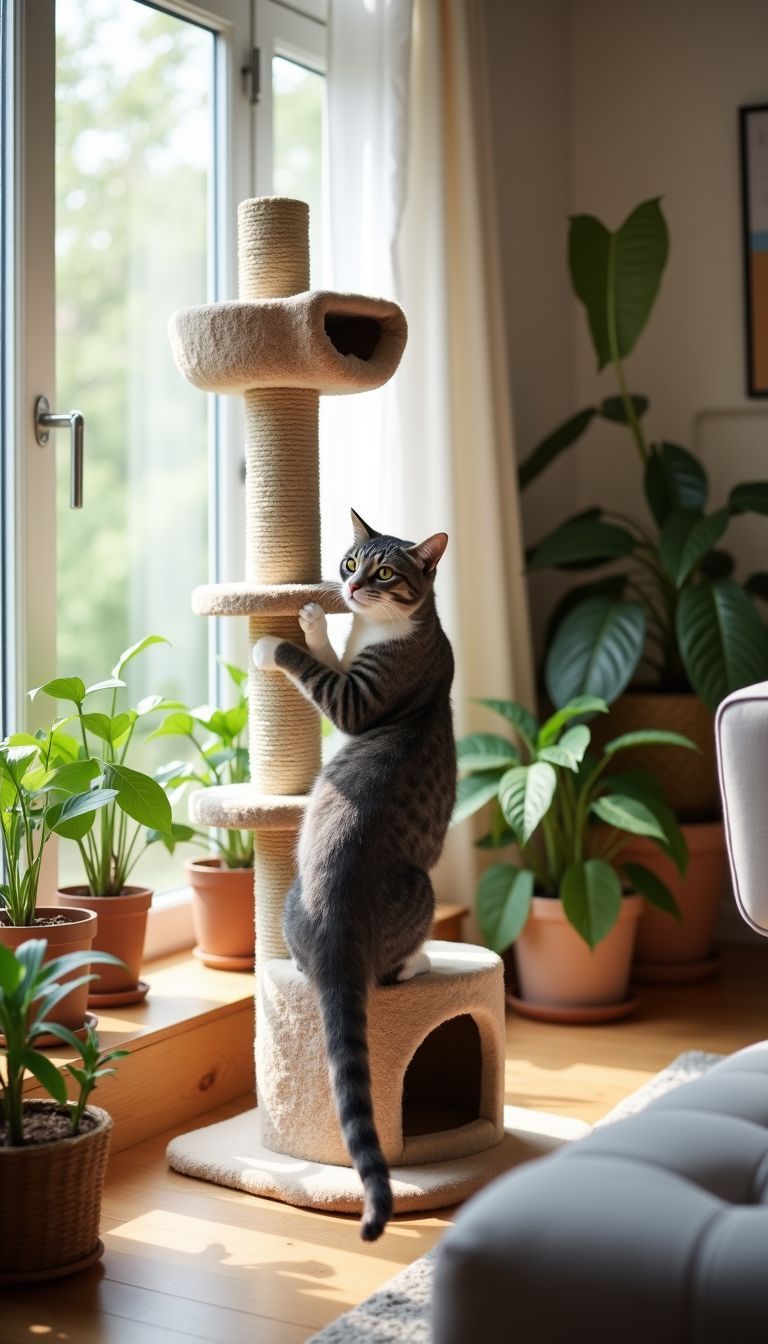
Creating a cat wall is fun! It gives your furry friend a place to explore. You can use corners or even doorways. Tailor the design to fit your cat’s needs. Enjoy watching them climb and play in their new space!
This website contains affiliate links. As an Amazon Associate and an affiliate for other programs, I earn from qualifying purchases. Clicking on an affiliate link may result in a commission being paid to me at no additional cost to you.

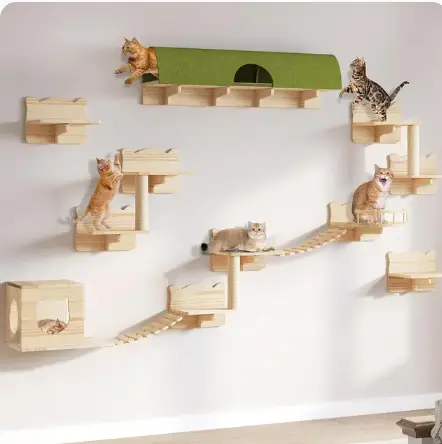
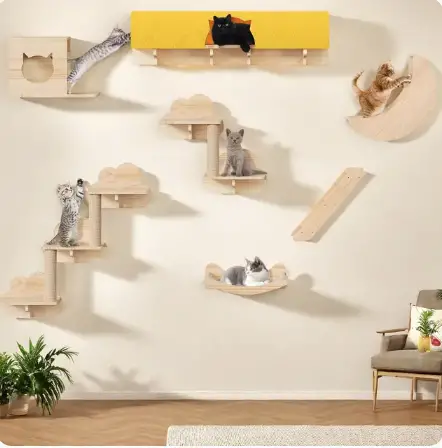
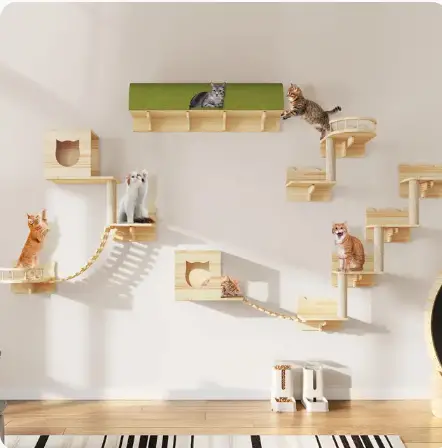
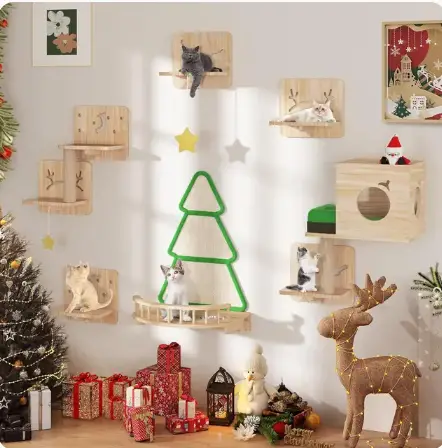
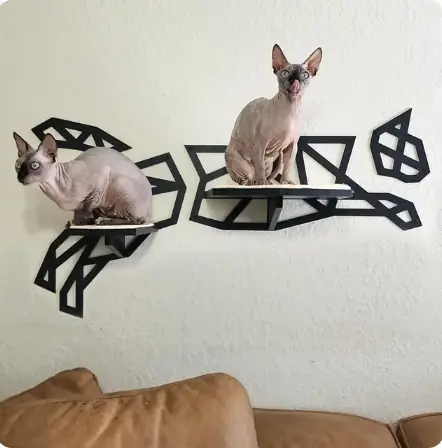
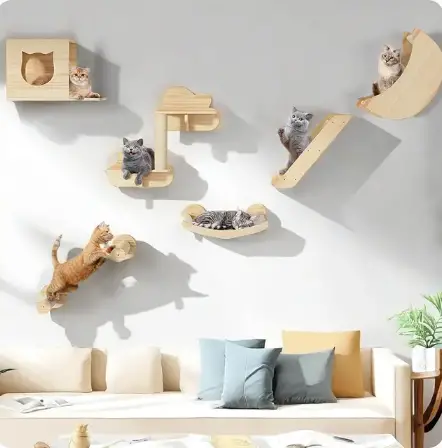

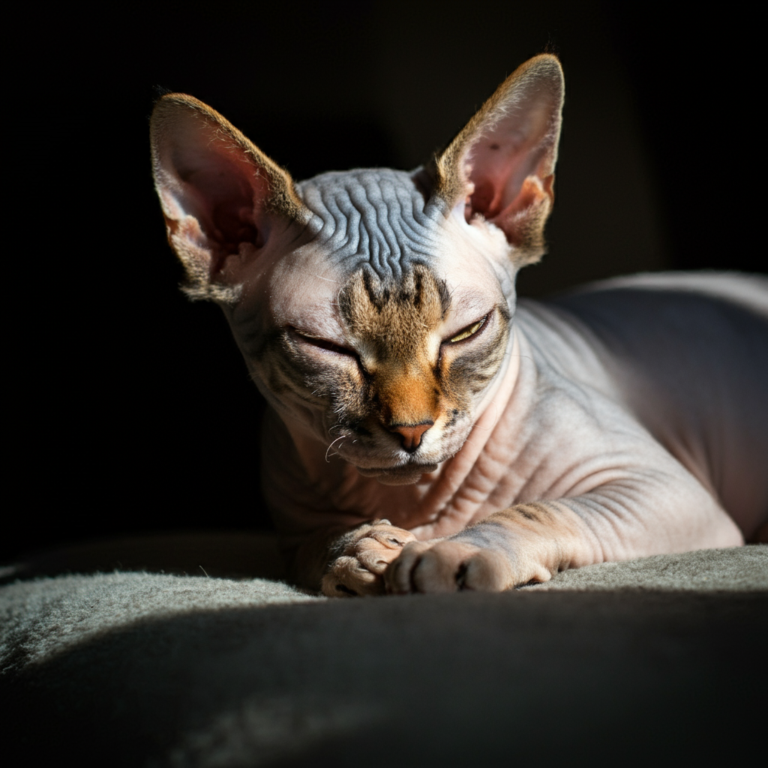

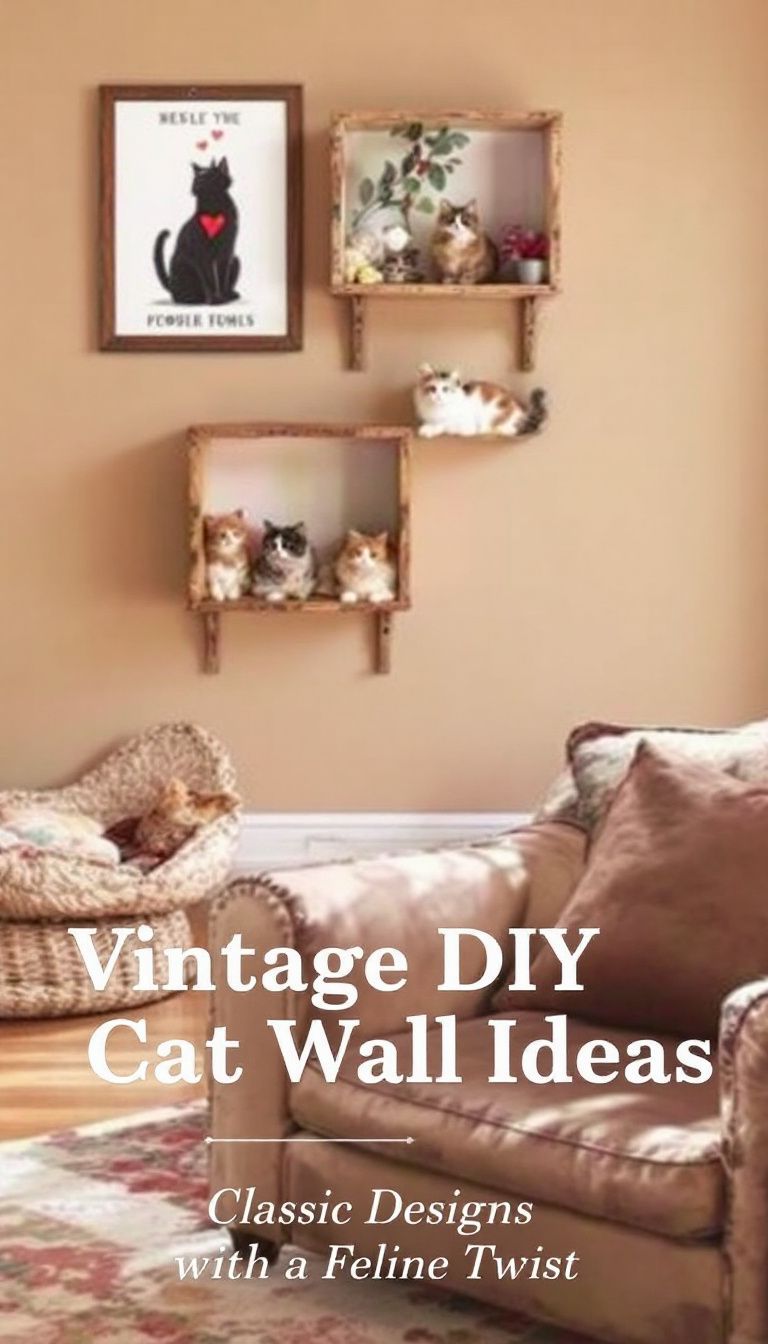


Leave a Reply